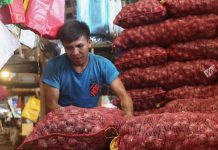The Department of Agriculture, together with United Nations – Food and Agriculture Organization, have inaugurated the country’s first disaster risk reduction and management operations center (DRRM) for agriculture on Monday in Quezon City.
Envisioned to be a monitoring hub for natural calamities that pose a threat to the agriculture sector, the center will serve as a crucial platform for decision makers and experts to enhance national preparedness and to coordinate response activities related to agriculture.
“In 2015, DA and FAO took a significant step together in formulating the country’s first Strategic Plan of Action for DRR in Agriculture and Fisheries,” said FAO Representative in the Philippines José Luis Fernández, adding that they have launched the Integrating Agricultural Sectors in the National Adaptation Plan (NAP-Ag) Programme in 2016.
NAP-Ag seeks to improve the country’s institutional capacity to operationalize climate adaptation and disaster response strategies. It is in this Operations Center that we will see these plans and strategies action,” said
The facility, which is located in Quezon City, was renovated, fitted and furnished for risk and disaster monitoring and assessment tools and equipment through funding provided by FAO and its development partners.
The partners include the German Federal Ministry for the Environment, Nature Conservation, Building and Nuclear Safety and European Commission’s Humanitarian Aid and Civil Protection (ECHO), among others.
Facing disasters head on
“Our country is vulnerable to disasters and natural calamities,” said DA Undersecretary Cayanan who delivered a message on behalf of DA Undersecretary for Policy, Planning Research and Development and Regulations Segfredo Serrano.
He pointed out that the country had experienced some of the worst cases of strong typhoons such as Pablo, Yolanda, and the recent Typhoon Lawin and El Niño, which significantly affected agricultural industries and production.
“The establishment of the DA DRRM Operations Center through Special Order No. 816 is a testament that DA is seriously working on a more precise, substantive and efficient DRRM in agriculture and fisheries. [The center] will ensure that all of DA’s DRRM-related activities, plans and programs are properly implemented and sustained, as well as managed and institutionalized,” he added.
In the Global Climate Risk Index 2017 published by GermanWatch, the Philippines ranks as the fifth most affected country in the world by climate-related disasters between 1996 and 2015. Government estimates cite that almost within the same period (1995 and 2013), the agriculture sector absorbed, on average, 27 percent of the adverse economic impacts caused by natural hazards and disasters. It rose to 37 percent within 2010 to 2013, when some of the world’s strongest and most destructive typhoons swept the country, including Typhoon Washi (local name: Sendong) in 2011, Typhoon Bopha (local name: Pablo) in 2012 and Typhoon Haiyan (local name: Yolanda) in 2013.
In the coming years, disasters and climate extremes are expected to impose greater risks to the livelihoods of farmers and fishers, as well as the country’s food and nutrition security. Government-led assessments also found that least 60 percent of the country’s land area is vulnerable to multiple hazards such as typhoons, floods, droughts, earthquakes, tsunamis, volcanic eruptions, and landslides, among others.
“The DA DRRM Operations Center will be instrumental in preparing the agriculture sector to tackle disasters and risks so that losses can be minimized, recovery and rehabilitation activities more quickly and effectively mobilized, and long-term resilience ingrained at all levels,” Fernández said.






